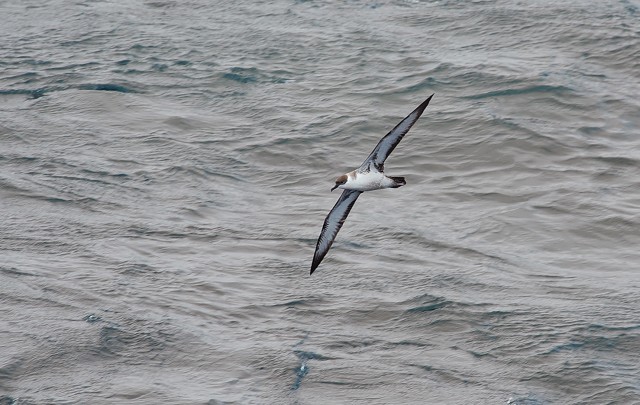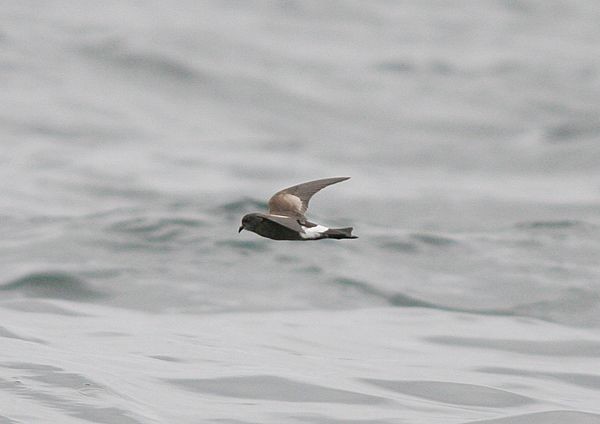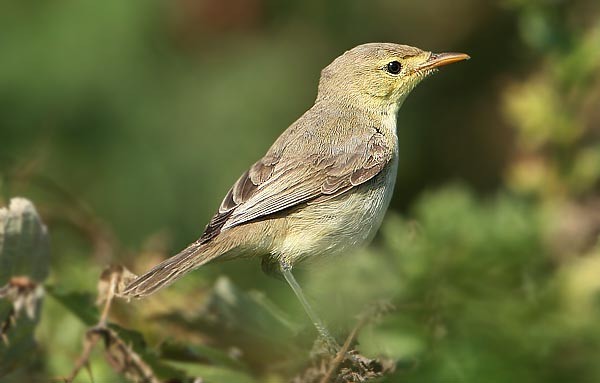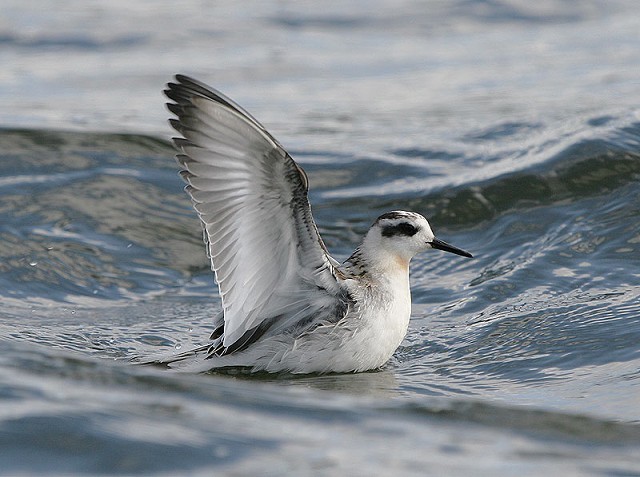There's been a three-month gap between now and when I initiated what I hoped would become a series of regular reports from the Isles of Scilly, but the truth is, until recently, there's just been a plain lack of birds to tell you about. Of course, there's never that much about in June and July anyway, and August has its limitations in terms of what can actually turn up, yet even still, Scilly's resident birders were complaining that this was the quietest summer they can ever remember.

Willow Warbler, Rostherne Mere, Cheshire (Photo: Steve Oakes, Aebs Limited)
Trying to take care not to peak too early in the season, I was out walking the lanes and byways of St Agnes for a few hours each day, barely making two Willow Warblers a morning and only twice having the tedium relieved by a Pied Flycatcher flitting off the footpath in front of me. Along the beaches, too—a delightful summer-plumaged Curlew Sandpiper apart—there was nothing in the way of rare or scarce migrant entertainment. I was away in northeast England on the afternoon that 69 Cory's Shearwaters flew past St Agnes in the space of an hour and I missed an Osprey flying directly over my head while I was inside concreting a new floor on Gugh! As if that wasn't enough: it's rained every single day for the past four and a half weeks, sometimes hard, sometimes very, very hard! (It's hammering down outside even now as I write this: if you're coming to Scilly this autumn make sure you bring your wellies; Barnaby Lane is now the River Barnaby.)
Do you need to hear any more hard luck stories? I was bent double, picking up flower bulbs from a muddy field, when a telephone call came through from one of my old friends in Ireland telling of Yellow Warbler, Northern Waterthrush and Solitary Sandpiper on Cape Clear Island. I'm not saying it was that phone call that sent me over the edge, for I wished them well and enjoyed the birds vicariously; it was forty-eight hours later, when the hope fizzled out that maybe we, too, on Scilly would be blessed by an early American arrival, that I reached the nadir of my summer's birding depression.
Fortunately, to an extent, as I strive to do always, I've managed to keep my sanity together by appreciating some of the commoner birds around me and the daily goings-on in the breeding bird world. When there are no rare birds around—which, let's face it, is most of the time—this at least helps to maintain a cheery outlook in public, such that I am able to mix and socialize with the non-birders on St Agnes without accosting them with glowering sulky stares and perpetual misanthropic moans and groans when things are not working out quite as I would have liked. Hats off then to Turnstones for providing me with some serene moments in their post-breeding multicoloured splendour, nosing their way through the flotsam and jetsam on these fantastic Atlantic-washed beaches; and Big Up to the Swallows and Song Thrushes that have kept me company in sulky moments at the conclusion of yet another fruitless morning or afternoon's birding. A pair of Common Sandpipers bred successfully on Wingletang Down—the first time the species has been confirmed breeding on Scilly.

Common Sandpiper, Islay, Argyll (Photo: Kev Joynes)
However, even this Pythonesque 'always looking on the bright side of life' approach has been tested to the limits in the face of this past month's almost total absence of visible migration. For relief, I did go out on three summer evening Sapphire pelagics from St Mary's this August, looking for petrels and shearwaters.
Birding from a boat has long been a source of great ambivalence for me. I've not got a great stomach for the sea and, as usual, I've always been glad to get back to dry land afterwards. Another thing with boat trips is, of course, that you can't just pack up and go home after five minutes if things are quiet—as I usually did when seawatching from Horse Point this summer. I got bored quite a bit on the boat on those three trips, as there were several hours with very few birds at all. The regular travellers told me they had recorded the fewest number of Wilson's Storm-petrels since trips began off Scilly eight or nine years ago. There were a couple of birds in early July, but a number of blank trips since then—another reason to lament the summer of '08, if one were that way inclined.

Great Shearwater, Scilly pelagic, Isles of Scilly (Photo: Steve Rogers)
There were two particular 'target' species for me on these trips this year: one was Wilson's Storm-petrel, the other Great Shearwater; the latter a bird I'd seen no more than half-a-dozen occasions in my life, a bird I somehow failed to see in five years in Ireland, perhaps one of the best places in the world to see it. As for Wilson's Petrel, it had been 21 years since I'd seen the species in British waters: one on the very first Scillonian pelagic out of Penzance in 1987. Certainly I saw several hundred individuals during nine summers in Cape May, but it was a different thing watching birds fly past there when you knew there was nothing a distant little black spot on the horizon could be except a Wilson's Petrel. I wanted to see one alongside Storm-petrels and compare it for size and jizz, etc.
The first pelagic trip was exceptionally boring, unless you like watching Storm-petrels, which, okay, I do, but then again I'd also seen plenty on three separate Scillonian crossings earlier in the year, so nothing to write about there. The second trip was looking barely better after an hour and half bobbing around 4 miles off St Agnes, when the gratifying sight of a close Cory's Shearwaters woke me from the doldrums. It was followed by five more in the second half of the trip—these journeys last about four hours—and, at last, by a beautiful Great Shearwater coming in to investigate the boat and then gliding off and landing, somewhat distantly, on the sea. This last sighting fulfilled an ambition on my wishlist in the short term, but the truth is I'd still like to see more—preferably from land next time! I still think it will be a long time before I'm fully satisfied I've seen enough Great Shearwaters. The Cory's though were brilliant; I don't need to see any more of those for a while.

European Storm-petrel, At Sea, Isles of Scilly (Photo: Steve Rogers)
The third pelagic trip, now in late August, was looking like being the deadliest boring of the lot. We'd been out there two hours and the number of Storm-petrels seen could easily have been counted on one hand. Only a pristine juvenile Kittiwake flying around the boat for a bit did anything to bring a splash of otherworldly beauty into our tawdry and miserable lives (well, mine anyway). Funnily enough—for I'm usually clinging steadfastly to the side railing on any boat I travel upon, staring at the distant horizon—I was the one who picked the best bird up first. I wasn't confident enough to call it, for here on board were several veterans of many, many Scilly pelagics, but there it was: 15% larger than the Stormies; all dark underwing; wrap-around white rump; looping butterfly-like flight. I'd just seen it turn and reveal an undercarriage of long legs protruding past the tail when John Higginson beat me to the shout: "Wilson's!" A minute's viewing for the ten birders aboard thus ensued. Was this the change of luck I needed to finally turn the corner this summer? I certainly expressed that thought out loud to the others. As they'd all seen plenty of Wilson's Storm-petrels in recent years, they, I presume, were not as caught up in the same flush of optimism as me, though reports of a change to an easterly airflow in the coming forty-eight hours also lightened our spirits (or was that the bottle of fine Irish whiskey Bob Flood produced on the way back?)

Wilson's Storm-petrel, Scilly pelagic, Isles of Scilly (Photo: Gary Thoburn)
Come Saturday morning and the easterlies arrived. Not that you would have noticed it if you hadn't looked up at the weather vane on the lighthouse. There was barely a movement in the trees, at least not in any sense that there was a wind blowing. What were moving were birds. A Pied Flycatcher was the first; then two others...a Whinchat, two Spotted Flys, and a Willow Warbler—all in the first twenty minutes of the day. By nine o'clock I was in danger of logging double figures of Willow Warblers for the first time in the year; Pied Fly sightings had increased to seven—several birds right out in the open feeding from fence posts. Two Green Sandpipers flew over; a late Swift; and a Reed Warbler showed well in a small bunch of sycamores in a lane off Covean. It was a happening morning with a real sense of excitement about it, even in the absence of anything notably scarce or rare. It was also beautifully sunny, mild and still.
A lunchtime check in increasingly hot sunny weather was surprisingly and disappointingly blank in its additions to the morning's tally, but at forty-thirty, after an afternoon of planting bulbs with Fran Hicks, long time Scilly birder and flower-farmer, I walked straight into a Wryneck. Actually I didn't see it very well, because (not for the first time) I overlooked it on initial glance, silhouetted briefly in some tamarisks. It was only when I lowered my binoculars that it dawned on me what I might have just missed. I forget how small and jaunty in 'jizz' these apparently unmistakable little creatures are sometimes. Fortunately I got a second shot at it very soon after, and it was there, sat in a bush; again—alas—a little too briefly. But the fact that it represented the first sign of a scarce migrant to the island made me feel a whole lot better as I proceeded on my way.

Wryneck, Kingston Seymour, Somerset & Bristol (Photo: Gary Thoburn)
I expected, as it was now rather late in the afternoon and I'd covered most of the island already, that the Wryneck would be the end of the entertainment for the day. Not so. Now that the thriving metropolis that is the St Agnes campsite throughout the summer had finally de-populated, I risked wandering past that way for the first time in two months. Almost immediately I was rewarded with a sleek, pale warbler flashing past me out of an arena of bracken on the southwest extreme of the St Agnes Downs, a bird that soon resolved itself to be a Melodious Warbler. Rather remarkably—for in my experience the species has been prone to hiding in vegetation for long periods—this bird continued to show for fully thirty minutes: working its way along the brambles at the base of a drystone wall; occasionally hopping out onto the ground, or flycatching out into the still evening air. Barely had I left this bird to itself when another 'flycatcher' appeared: this one turning out to be a classically marked juvenile Red-backed Shrike. This bird entertained for five minutes: frequently sallying vertically from its exposed perch, high into the air, and once, rather efficiently, ensuring there was one less Red Admiral in the world.
Now the panic button was pressed in my mind. With just over an hour and a half's light left, what else was this evening and this island holding? There were at least 30 Swifts hawking around low over the fields and hedges, a remarkable count for this time of year and the first any of us had seen in weeks. Another Pied Flycatcher here, another Willow Warbler there: I set off at practically a run, despite tired legs and back, across Wingletang Down, hungry for more migrant action. As it was, I added another Wryneck—this one dead easy: right out in the open—and a second Melodious Warbler (also flycatching on this memorably still, enchanting evening) in a hedge near our farm. All of a sudden the island had come to life and a great wave of satisfaction engulfed me. Now, in this heightened state of mind, things that had become stale and dull over the preceding weeks became sharply enhanced with a new and yet previously remembered sense of beauty. The moss-clad Troytown Carns, standing majestically at the very edge of Britain; the newly formed purple shoots of heather contrasting starkly with the senescent brown bracken; the loud, clear ringing tones of a Greenshank, flying over at dusk.

Melodious Warbler, Portland, Dorset (Photo: Gary Thoburn)
And what optimism for the coming months this state of mind aroused.
I took this spicy feeling of rejuvenation into the field with me next day, the first of September, and had barely brushed the sleep from my eyes when I stumbled straight into a Buff-breasted Sandpiper on Periglis Beach. As easy as that! The chances are this was the bird that had been seen on nearby Bryher for three days—so I can't call it a bona fide personal 'find'—but I'm not going to quibble about that. Instead it was a joy (and continues to be at the time of writing, ten days later) to re-acquaint myself with this inimitable little wader after a two-year gap. Ideally—like Wryneck, say, as another example—this would be the type of bird that one would like to see every autumn. Perhaps living on Scilly, I've now got a chance?
There was rather a stiff breeze blowing the first morning of this Buff-breast, and it wasn't until the evening, when I went back again for a second look, that I got to sit down with my scope and enjoy a protracted, settled view of the bird. I forget—in the gaps between sightings—just how small this lovely bird really is. Beautifully rich buff all the way down the unmarked underside (save a few black spots at the edge of the upper breast), its mantle was scalloped intricately in blacks and browns and the crown finely but distinctly spotted black. The legs were yellow. This is the third Buff-breast I've found myself on this side of the Atlantic, and like the others, this one was running about a seaweed-strewn beach; I've never come across one on the open grassy areas the species usually favours. There was plenty of insect and invertebrate food for it among the tangled fronds at the high-water mark, and it poked and chased after them in a typically lively manner.
And that wasn't all: just minutes after finding the Buff-breast in the morning, I put up my binoculars to a small bird swimming in a nearby flock of Black-headed Gulls at the water's edge—a Grey Phalarope: a juvenile moulting to first-winter. What a crippler—another species you just don't get to see often enough! Quite confident the Sandpiper would be around for longer than the Phalarope, I chose to spend my twenty minutes before work creeping up closer to the latter, and enjoying a long, leisurely stare through my binoculars. After all that hard work and no reward in August, it was fantastic to be back and watching great birds again. Goodbye Summer; Hello Autumn.

Grey Phalarope, Shustoke Reservoir, Warwickshire (Photo: Steve Seal)
Several of those migrants from the fall in late August continued to be seen to the end of the first week in September. Certainly the same Red-backed Shrike was around for eight days, and at one point I saw it in the same bush as a Wryneck. Actually it became quite difficult to discern the total number of Wrynecks on the island as new ones popped up in different locations from time to time; I reckon there was a minimum of four, maximum seven. I finally got to see one really well as I came out of the Coastguards Café one lunchtime and disturbed one from its feeding in the crevices of a drystone wall. I stood back for a minute and it obliged by dropping back down to the wall and allowing me five minutes' excellent viewing. One of the same, or perhaps another, Melodious Warbler turned up again a week later—in a location quite different from where I'd seen the original two—and many Pied Flycatchers hung around for a week as well. As I mentioned before, the Buff-breasted Sandpiper was seen every day throughout the period, and two more delightful Grey Phalaropes spent twenty-four hours bobbing about close inshore off one of the far eastern coves. It was a very pleasant week. Add to that the fact that one morning I got up very early to see 4 Cory's Shearwaters pass close by the seawatching spot at Horse Point, followed an hour later by a fabulous Great Shearwater—hurrah!—and you have a real all-round, classic early-September set of birds, all from one little island. I was very pleased.
Yet still there is a little more to tell before this piece is done. It is now 12th September and in the last couple of days an Osprey has flown over the island (that makes up for the one I missed earlier), an adult Pectoral Sandpiper has appeared alongside the Buff-breasted on Porthcoose Beach, and three days ago I came across a Short-toed Lark running about the footpath that runs between Wingletang Down and Covean. It was still there yesterday. Every day now there is something of interest to see on St Agnes, whether it just been a new Reed Warbler, the first Grey Wagtail or Kestrel of the autumn, or even an influx of 80-odd Sanderlings as has occurred recently. I still have one or two work projects to try to complete in the next fortnight in order to allow me a proper holiday at the end of this month, but I've still plenty of time each day to wander about birding. I'm very pleased to have found that I can strike a good work/birding balance here on St Agnes that I couldn't achieve at my former patch in Ballycotton, Ireland. I still miss Ireland at times, I really do—the landscape and my birding friends as much as anything—but I failed to find a place to live permanently and enough employment opportunities to keep me in Ballycotton forever. I had to commute from Cork City, 35 miles away, and that put certain restrictions on a birder who was always used to living by the seaside, and used to be able to pop in and out the house depending on the conditions. I wonder how much gets missed at birding locations where people can only get there at weekends and can't take advantage of the subtle little weather changes that take place at different times of the day, as I've been able to do on St Agnes.
Of course, I'm living on an island 27 miles off the mainland at the extreme southwesterly tip of Britain. That's bound to give me a HUGE advantage! I look forward immensely to the coming sixty days (yep, I've counted 'em) to 10th November, the date I shall finally consider the autumn to be over, and when my chances of finding a mega start to go rapidly downhill. I wonder how I'll react to the visiting birders who will inevitably begin to arrive in their hundreds over the coming weeks? It will be interesting to see. Of course, I've been on that side myself, charging around the islands with a blinkered vision: focusing only on the next lifer or collectable year-tick. I hope I won't begrudge anybody pipping me to a find somewhere right under my nose. I hope even to get into some off-island twitching myself. We'll see.
Saturday 13th September
Liverpool 2 Manchester United 1—now that's the best rarity I've seen all year! My shout when the winning goal went in during the second half must have rivalled the famous Short-toed Eagle 'shout' on these islands in October 1999. And the sun? Was that the sun I saw high in the sky yesterday? I'll have to fill out a Rarities Form for that one, I suspect.
Have a good autumn.

